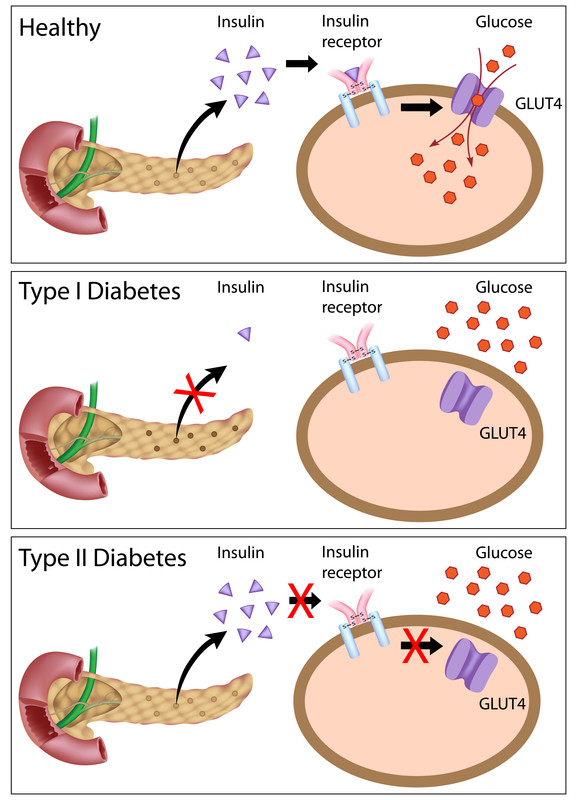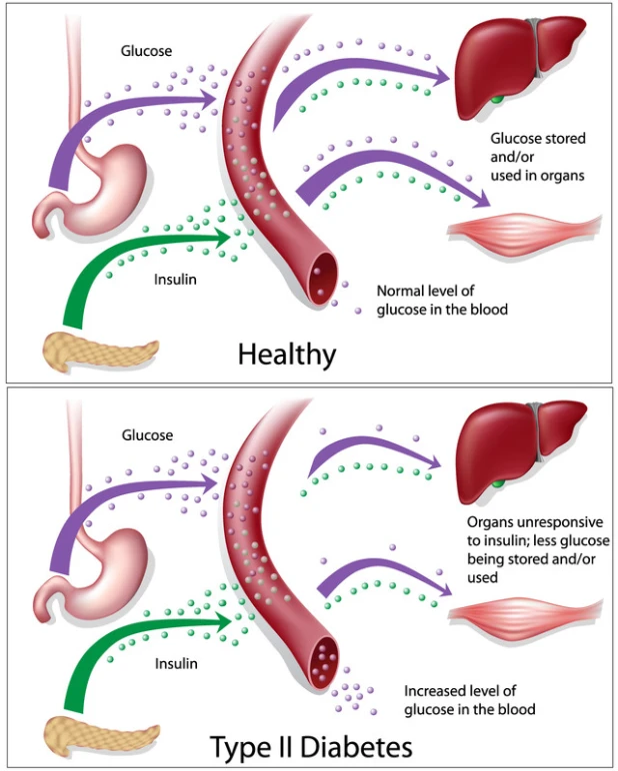Jack’s Health: Type II Diabetes Mellitus
Signs and Symptoms
Signs and symptoms of type II DM often develop slowly. You can live with type II DM for years and not know it. When signs and symptoms are present, they include:
- Increased thirst
- Frequent urination
- Increased hunger
- Unintended weight loss
- Fatigue
- Blurred vision
- Slow-healing sores
- Frequent infections
- Numbness or tingling in hands or feet
- Areas of darkened skin, usually in the armpits & neck
Causes
Type II DM is primarily the result of two interrelated problems:
How Insulin Works
Insulin is a hormone that comes from the pancreas and regulates how the body uses sugar in the following ways:
- Sugar in the bloodstream triggers the pancreas to secrete insulin
- Insulin circulates in the bloodstream, enabling sugar to enter the cells
- The amount of sugar in the bloodstream drops
- In response to this drop, the pancreas releases less insulin
| Type | Examples | Appearance | Onset | Peak | Duration |
| Rapid-acting | Apidra (insulin glulisine) | Clear | 10-15 mins | 1-1.5 hrs | 3.5-5 hrs |
| Fiasp (faster-acting insulin aspart) | Clear | 4 mins | 0.5-1.5 hrs | 3-5 hrs | |
| Humalog (insulin lispro) | Clear | 10-15 mins | 1-2 hrs | 3-4.75 hrs | |
| NovoRapid (insulin aspart) | Clear | 9-20 mins | 1-1.5 hrs | 3-5 hrs | |
| Short-acting | Entuzity (insulin regular) | Clear | 15 mins | 4-8 hrs | 17-24 hrs |
| Humulin R, Novolin ge Toronto (insulin regular) | Clear | 30 mins | 2-3 hrs | 6.5 hrs | |
| Long-acting | Basaglar (insulin glargine biosimilar) | Clear | 1.5 hrs | Does not apply | 24 hrs |
| Lantus (insulin glargine U-100) | Clear | 1.5 hrs | Does not apply | 24 hrs | |
| Levemir (insulin detemir U-300) | Clear | 1.5 hrs | Does not apply | 16-24 hrs | |
| Toujeo (insulin glargine U-300) | Clear | 1.5 hrs | Does not apply | Up to 30 hrs | |
| Tresiba (degludec) | Clear | 1.5 hrs | Does not apply | 42 hrs |
Insulin Mixtures
For convenience, there are premixed rapid- and intermediate-acting insulin. The insulin will start to work as quickly as the fastest-acting insulin in the combination. It will peak when each type of insulin typically peaks, and it will last as long as the longest-acting insulin.
Examples include:
- 30% regular and 70% NPH (Humulin 30/70, Novolin ge 30/70)
- 50% lispro and 50% lispro protamine (Humalog Mix 50)
- 25% lispro and 75% lispro protamine (Humalog Mix 25)
- 30% aspart and 70% aspart protamine (NovoMix 30)
The Role of Glucose
Glucose – a sugar – is a main source of energy for the cells that make up muscles and other tissue. The use and regulation of glucose includes the following:
- Glucose comes from 2 major sources: food and the liver
- Glucose is absorbed into the bloodstream, where it enters cells with the help of insulin
- The liver stores and makes glucose
- When glucose levels are low, the liver breaks down stored glycogen into glucose
In type II DM, this process does not work well. Sugar does not enter the cells, builds up in bloodstream. The beta cells in the pancreas release more insulin. Eventually these cells become impaired.
In type I DM, the immune system mistakenly destroys the beta cells, leaving the body with little to no insulin.
Risk Factors
Weight – being overweight or obese is a main risk
Fat distribution – storing fat mainly in the abdomen (men waist >40 inches, women waist >35 inches)
Inactivity – physical activity keeps weight done, and uses up glucose as energy, makes cells more sensitive to insulin
Family history – increases if parent or sibling has type II DM
Race and ethnicity – Black, Hispanic, Indigenous, Asian, Pacific Islanders
Blood lipid levels – increased risk associated with love levels of HDL cholesterol and high levels of triglycerides
Age – increases with age, especially after age 45
Prediabetes – blood sugars higher than normal, but not high enough to be classified as diabetes, if left untreated often progresses to type II DM
Pregnancy-related risks – increases if you develop gestational diabetes or if you give birth to a baby weighing > 9 pounds
Polycystic ovary syndrome – common condition characterized by irregular menstrual periods, excess hair growth and obesity-increases the risk of diabetes
Complications and Frequent Comorbidities
Heart and blood vessel disease – increase risk of heart disease, stroke, hypertension, and atherosclerosis
Neuropathy in limbs – overtime nerves are destroyed, resulting in tingling, numbness, burning pain or eventual loss of feeling. Begins at tips of toes or fingers and gradually spreads
Other nerve damage – damage to heart nerves can contribute to irregular heart rhythms. Digestive nerve damage may lead to nausea, vomiting, diarrhea or constipation. Men, erectile dysfunction.
Kidney disease – may lead to irreversible end-stage kidney disease
Eye damage – cataracts and glaucoma, may damage the blood vessels in the retina
Skin conditions – more susceptible to bacterial and fungal infections
Slow healing – cuts and blisters can become seriously infected, severe damage might require amputation
Hearing impairment
Sleep apnea – obstructive sleep apnea is common, obesity may be the main contributing factor. Not clear if treating sleep apnea improves blood sugar control
Dementia – seems to increase risk of Alzheimer’s disease and other dementia disorders. Poor blood sugar control linked to more-rapid decline in memory and thinking skills
Prevention
- Monitor and/or lower blood pressure and cholesterol
- 30 minutes of activity per day five days per week helps lower risk of developing type II diabetes by 58%
- Eat a healthy diet, including less fats, more fiber, whole grains, veggies, fruits, lean meats
- Manage weight and BMI



